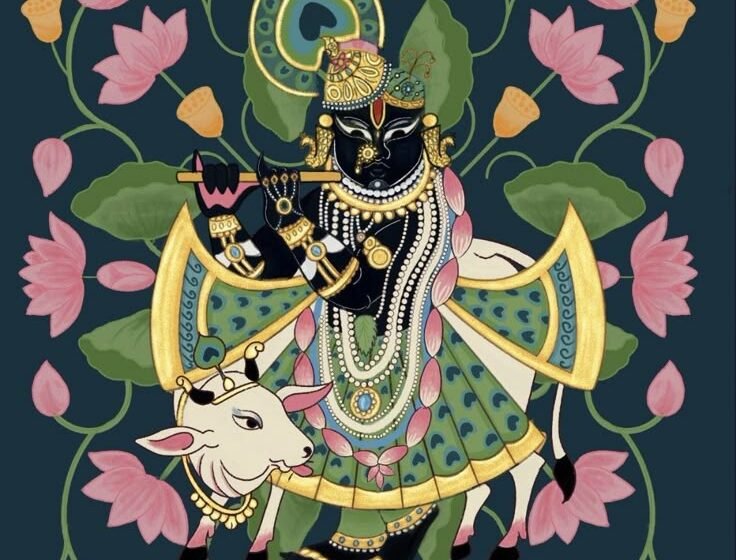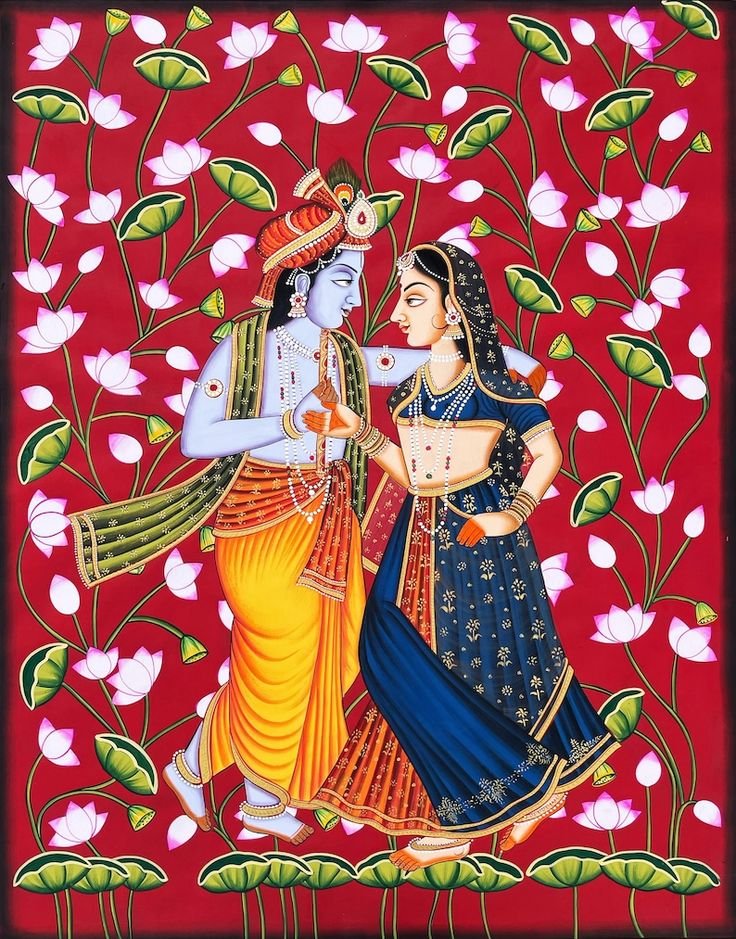Pichwai Paintings: A Tapestry of Devotion

Pichwai paintings are a vibrant and intricate form and style of Indian art which has been captivating art enthusiasts and devotees alike for centuries. Because of their initial origination in the temples of Nathdwara in Rajasthan, these paintings allow us to witness the magnificence of the beauty of devotion blending with artistic genius. Apart from their aesthetic value, pichwais are meant to tell those who are illiterate stories about Krishna.

A Glimpse into History
The Nathdwara temple, built in the 17th century, became a significant pilgrimage site for devotees of Shrinathji. Originating in 17th century Nathdwara, Rajasthan therefore, this art has spiritual significance in Indian art. These beautiful objects were created to decorate temples to celebrate important events in the life of Lord Krishna, especially the Shrinathji form. The word “Pichwai” is derived from the words pich (back) and wai (hang), indicating that they are behind the temple deities. Traditionally executed on clothes, these paintings depict the beautiful image of Krishna in a powerful setting, often surrounded by floral patterns and pastoral imagery. Over the centuries, Pichwai art has transcended its religious function and become a cultural symbol.

To enhance the devotional experience, the temple priests commissioned artists to create large-scale paintings depicting Shrinathji in various moods and postures. These were at first in the very beginning made by the artisans only on commission by the chief priests of temples. However, in the coming centuries, as the sect grew to various part of India such as Gujarat and Mathura, the art styles reached those places as well. Pichwais were made to be taken by pilgrims from Shrinathji temple but were also commissioned by wealthy families.
At the beginning of the 19th century, Indian businessmen and upper class began to choose Westernized art school painting techniques instead of traditional painting techniques such as pichwai. Artists began to slightly modify their paintings in order to stimulate the pichwai market. Pichwais began to use Western influences such as oil painting and realism along with traditional works to change the stylistic process.

Themes
When one is to look at several paintings that are created by talented pichwai artists, it is impossible to not notice the themes of commonalities among most of them, some of them occur very often in these paintings. The lotus is one of the most common symbols in Pichwai paintings. The lotus flower represents understanding, beauty, and purity. The lotus often appears in various stages of bloom in Pichwai’s paintings, symbolizing the soul’s journey from darkness to light. The lotus is also associated with Lord Krishna, who is sometimes seen holding a lotus in his hand.
The peacock is another important symbol in Pichwai’s paintings. The peacock is a symbol of grace, beauty, and nobility. Lord Krishna is often depicted with feathers in his hair and is also associated with the peacock in Hindu mythology. In Pichwai art, the peacock occasionally dances, symbolizing the joy and fulfilment that comes from devotion to Lord Krishna.

Another important symbol in Pichwai’s paintings is the cow. Cows are revered in Hinduism and are often associated with fertility, wealth, and abundance. In Pichwai paintings, cows often appear in front of Lord Krishna, also known as the cowherd. In this image, the cow represents the wealth and prosperity that comes from life for Lord Krishna.
The Gopis, or cowherd girls, are often featured in Pichwai paintings, particularly in Shringar Pichwais. They are depicted as beautiful and devoted companions of Shrinathji. Other theme the is seen repeated is that of the nature. The natural world, including trees, flowers, and animals, is frequently depicted in Pichwai paintings. It symbolizes the divine beauty and harmony of the universe. Pichwai paintings are rich in religious symbolism. The colours, patterns, and motifs used in these paintings have deep spiritual significance. For example, the colour red symbolizes passion and devotion, while the colour blue represents tranquillity and spirituality.

Types of pichwai paintings
Pichwai paintings, a vibrant and intricate art form, are categorized into four primary types, each with its distinct characteristics and themes:
Shringar Pichwai
These paintings are characterized by their romantic and playful depictions of Shrinathji. The divine child is often portrayed adorned with exquisite jewellery, surrounded by beautiful Gopis, and engaged in amorous activities. The focus is on celebrating the divine beauty and enchanting nature of Shrinathji.
Shayan Pichwai
Shayan Pichwais depict Shrinathji in a serene and tranquil state, often reclining on a bed or a swing. These paintings emphasize the divine serenity and peacefulness associated with sleep. The artist’s skill is evident in capturing the intricate details of the sleeping deity’s form and the serene ambiance surrounding him.

Nitya Leela Pichwai
Nitya Leela Pichwais offer a glimpse into the daily life and playful activities of Shrinathji. They depict the divine child engaged in various pastimes, such as bathing, dressing, playing with his friends, and tending to cows. These paintings highlight the divine child’s mischievous and endearing nature, providing a glimpse into his divine childhood.
Puranic Pichwai
Puranic Pichwais delve into the realm of Hindu mythology, depicting scenes from the lives of Lord Krishna and Radha. These paintings often portray epic battles, divine romances, and spiritual teachings. They showcase the divine couple’s eternal love, their role in cosmic events, and their significance in Hindu mythology.
Each type of Pichwai painting has a unique perspective on the deity, capturing the essence of Shrinathji’s various moods and activities. Through diverse themes, vibrant colours, and captivating imagery, pichwai’s paintings continue to inspire and engage viewers, preserving India’s rich and spiritual heritage.

The Legacy of Pichwai Paintings
Pichwai’s paintings have left a lasting mark on Indian art and culture. They continue to inspire artists and makers, and their beauty and spiritual significance are recognized worldwide. Today, Pichwai paintings are appreciated not only for their beauty, but also for their cultural and historical value. Contemporary artists have reinterpreted Pichwai styles and techniques to create new modern images. This new interest has helped keep the tradition of Pichwai paintings alive and thriving.
Conclusion
Pichwai paintings are a testament to India’s rich heritage. They provide insight into the passion and spiritual devotion of the people of Rajasthan. By studying and appreciating these beautiful images, we can gain a deeper understanding of Hindu mythology, culture, and spirituality. As we continue to celebrate the beauty and significance of Pichwai paintings, we ensure that this art form continues to inspire generations to come.


